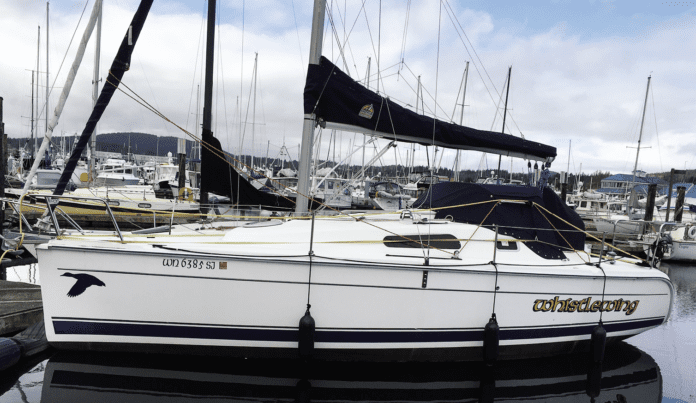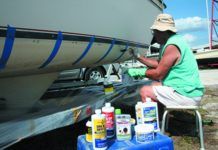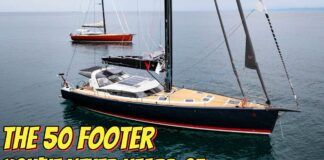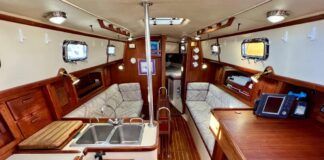THE WINCH HOLSTER
With regards to your recent report on winch handle holders (see “Winch Handle Holders,” PS July/August 2023), another approach to winch handle management is the holster.
For the sailor who customarily sails singlehanded (like me), or who doesn’t share duties well with others (also like me), “wearing” a winch handle obviates the usual storage and deployment challenges.
I made mine by purchasing a clip-on tool holder from Home Depot; zip-tying it to my harness (which I don for every sail); and adding a loop of light shock cord to secure the handle while still allowing for easy retrieval.
The holster keeps the winch handle always at the ready, and because the holster is positioned high on the chest, it doesn’t compromise other activities. Other than when I need to tighten a line, the holster is so comfortable I forget it’s there.
Bill Wiselogle
Hunter 27, Whistlewing
Anacortes, WA
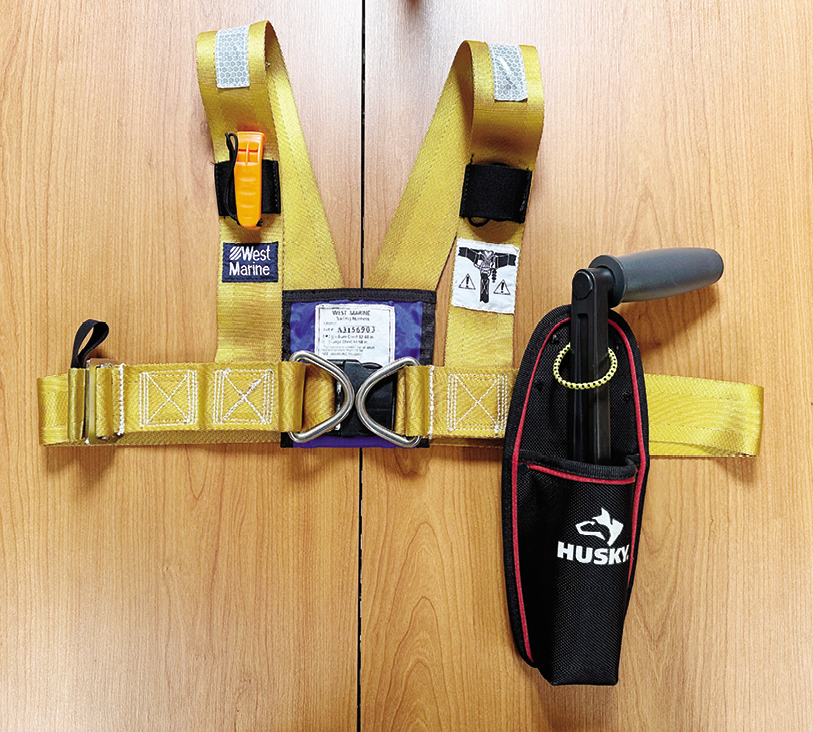
Shortly after we published his report on winch handle stowage, tech editor and renowned spendthrift Drew Frye improved his rugged DIY winch handle design to incorporate very high bond tape (see “Through Bolt Alternatives”).
Initially, Frye installed a length of PVC pipe to hold his mast winch handle and found it was very handy. For years, he had the ubiquitous Lewmar molded plastic rectangular holders in the cockpit. Although he did not immediately change them, he knew that a PVC pipe holder would serve just as well, and his last report in Practical Sailor mentioned this.
Recently, the $45 Blue Performance winch handle bag he also had in the cockpit finally became so damaged by the sun that it was beyond repair, so he decided to replace that with a do-it-yourself PVC pipe holder. Here are some of the advantages that Frye has noticed so far:
• It fits well in the corner of the cockpit. Every cockpit has unused corners.
• Because it easily mounts with very high bond tape (3M #5962), there are no holes to drill.
• The angled cut at the top automatically rotates the handle against the bulkhead, so it is out of the way. Mounting the pipe on an angle will also create this effect, but on Frye’s boat this would cause the handle to get in the way.
• To remove and return the handle to its holder is fast and easy.
• A downside to this design is that it does not fit fat, floating winch handles. (Frye prefers non-locking handles because they are faster to engage and disengage, so this isn’t a factor for him.
For the first time in years Frye isn’t kicking the Blue Performance bag, bumping into handles that protrude into the cockpit, or discovering in mid-tack that a socket has jammed in a genoa winch.
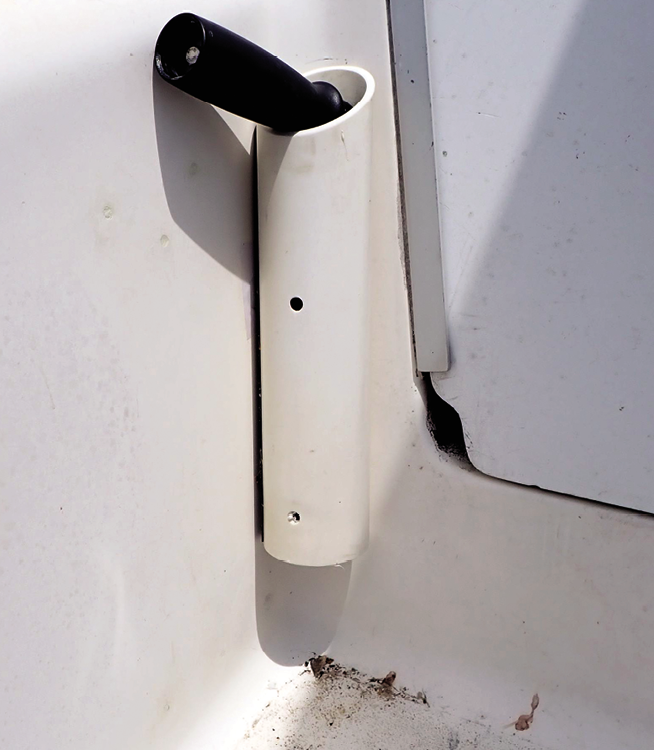
We wouldn’t be surprised if a commercial vendor picks up the idea and starts selling it. Frye has shared in Practical Sailor dozens of novel product ideas ranging from fuel vent filters to snubber hooks. Several marine companies have used these ideas to improve or develop new products.
THE MYSTERY SEA DOG
Regarding your recent blog post on pets (see Inside Practical Sailor, “What is the Best Pet for a Boat?”), we have a wonderful candidate for a sea dog. Ana is most likely a Labrador-schipperke mix. Born without a tail under a porch near the beach in Golfito, Costa Rica, Ana was given to us on my 70th birthday when she was six weeks old. She has lived with us for the past 13 years, spending 6 months afloat in Costa Rica and six months ashore in Oregon.
Ann loves our Gulfstar 41, Someday, and enjoys the travel. She weighs 36 pounds, and will go into her crate at a mere suggestion. She endures all the poking and looking by inspectors with the patience of a dog who knows that she is going to be petted and will get a treat when the indignities over.
I can’t leave her with others for fear they will not return her. She loves swimming in the waters of Central America, but has no use for the cold waters of our summer home in Oregon.
I have been unable to induce her to use the poop deck. Instead, she prefers messing up the anchor and rode.
William Nokes
Someday, Gulfstar 41
Chetco Cove, Oregon
MOUNTAIN DOGS TO KITTIES
Regarding your discussion of pets aboard, we are live aboard sailors for more than 12 years, spending the last few years in Asia. But before then, we used to sail almost every week year-round in northern Europe. We had several dogs, including Bernese mountain dogs.
These were definitely too large for our custom 50-footer, and they did not really like sailing. They did like being with us, motoring, and exploring busy marinas. They also loved to catch snow whilst standing on the foredeck.
Our next pet was a beagle, a cute little fellow, who was full of energy and liked sailing. Sitting between our legs was his favorite spot. He never howled as a true beagle until one day we got into the tail of a hurricane near the English Channel. He was a super dog in many ways but he also shed a lot, which made us keep him as much as possible outside or in just one cabin. He also had a tendency to run off ashore, chasing rabbits or other game.
When the beagle grew to old to sail, our oldest child took care of him. After a few years, we found a cat and he was on board for a while. He was a beautiful cat, did not shed much, and even watched sailing channels on YouTube, but the furniture scratching caused some drama. One day he went to stay with someone for a while, and disappeared.

After the cat, we were inspired to look for a smaller breed dog. A friend then visited with a puppy, a shih tzu, and that’s what we have now. He loves to run on beaches, which he does almost daily. He likes to go for sea swims and to dig for seafood. He is happy to be on board. He is small, and is good about relieving himself at the spot where we taught him. He is not noisy.
He is large enough to scare away intruders and stronger than he looks. He is nice with children and with most strangers. He likes to play, but sometimes just wants a belly rub. All-in-all this breed seems to be one of the best to keep on board.
His long fur may not be great for sailors without air-conditioning in the tropics. Our aircon is on 24 hours a day. Just after shaving, we will let him stay outside, but only in the shade.
Walter van der Boor
Vage Kennis, Bavaria 46
Indonesia
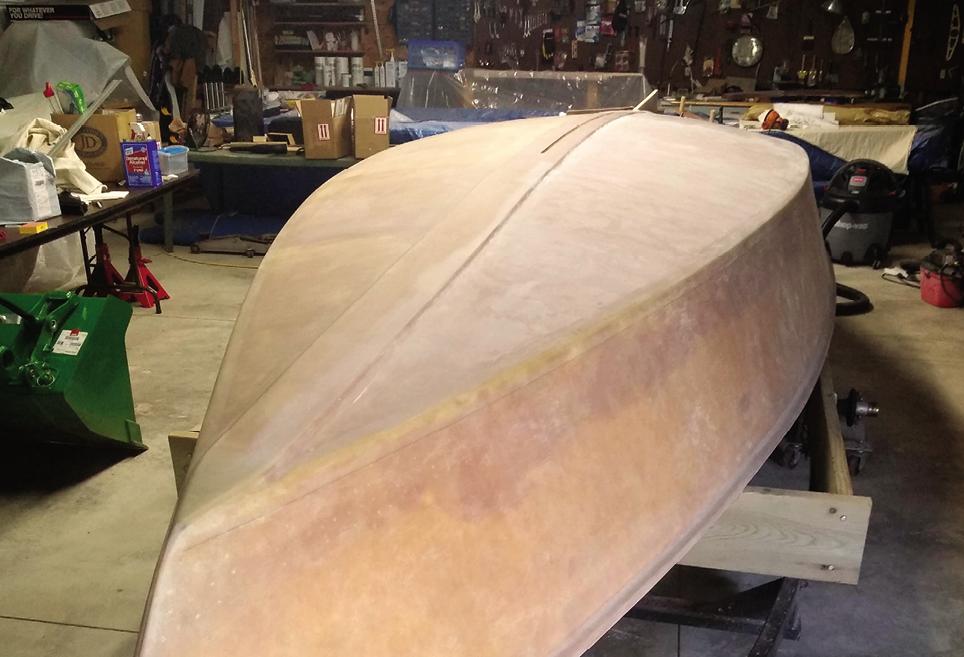
WEST SYSTEMS CORE REPAIR
I’m currently working on the restoration of two Lightnings, and using the West Systems method of drilling holes to dry the foam core. I used large plastic sheeting to bag the boat, which was turned with the drilled holes facing downward to help speed the process. I had a dehumidifier set on high, a drain hose leading out of the bag, and a fan to help circulate more air. I used a non-destructive moisture meter, and painters tape to mark moisture readings at the start, so I could monitor progress. Over time, the moisture dropped to nothing. After that, we injected West System slow-cure epoxy, using corks to plug the holes as we progressed. The first hull now sounds solid as rock. The foam hull core was wet but not rotted, and there was considerable delamination. One boat had suffered from a previous owners failed attempt to re-core. We stripped that out and re-cored with balsa. You could park a truck on that foredeck now. West Systems tech support was great throughout the process.
Scott Boshart
Escape Vector, Lightning
Lake Huron, Michigan
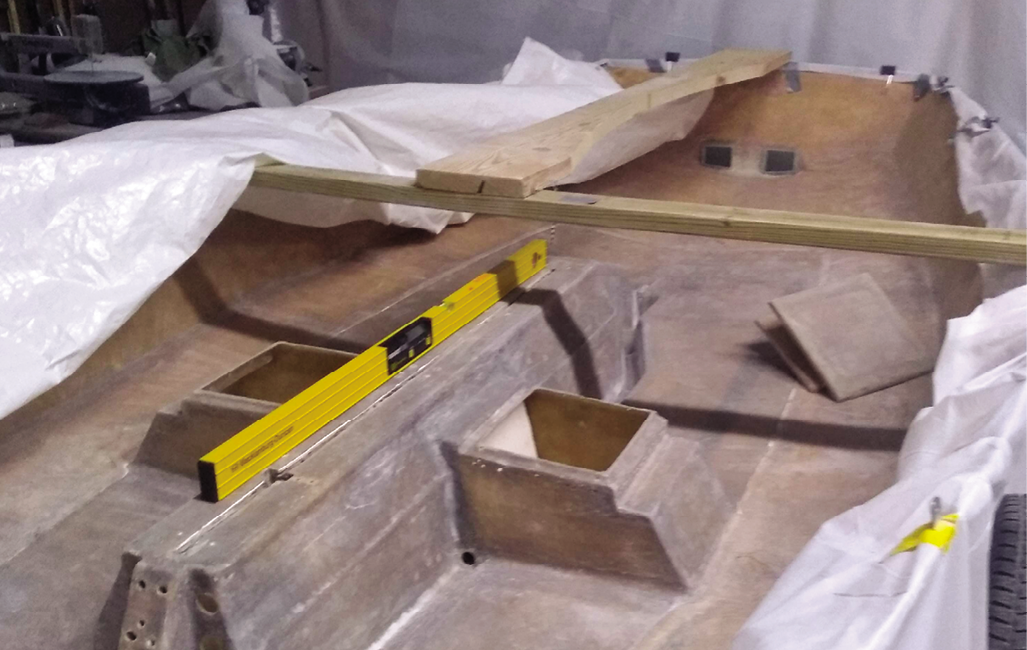
As a subscriber, you have free access to our back-issue archive—more than 5,000 unique reports. To read the complete report as it appeared in print, we recommend you download a PDF copy of the entire issue in which the article appeared. The print issue is one month after the online published date. For example, an article published online on July 13, 2021 can be found in the August 2021 print issue. Complete issue PDFs dating back to 1998 are online can be found at www.practical-sailor.com/category/full-issue.
STORM PREP
If you live in a hurricane zone, we’ve got what you need to prepare. Start with our July 2008 report, “Lines, Snubbers, and Other Gear for Battening Down Ahead of Storms” and Technical Editor Ralph Naranjo’s “Tropical Storm Do’s and Don’ts”
(November 2011). For cruising sailors, PS recently published an in-depth four volume series on securing your boat at the dock, at anchor, or on a mooring for any type of storm (www.practical-sailor.com/product/hurricane-preparedness-guide-complete-series).
NEW BOAT SHOPPING
The PS archive includes dozens and dozens of sailboat reviews, from trailer sailers and small cats to racer-cruisers and bluewater voyaging boats built for a family of four. Also the two-volume ebook series “Entry-level Cruiser-Racer” is a compilation of boat reviews of popular racing-cruising boats; available in the online bookstore (www.practical-sailor.com/product/entry-level-sailboats-complete-series). If you’re planning to carry out a preliminary boat survey—or just want to be well-versed when you go shopping—read “Do-it-yourself survey checklist for boatbuyers,” in the June 2012 issue.
GALLEY OUTFITTING
Before you outfit your galley, be sure to read these reviews of galley tools. For those who need quick-fix dinners that can basically cook themselves while you’re on watch (or enjoying cocktail hour), you’ll find our report on pressure cookers in the December 2010 issue and thermal cookers in the May 2016 and September 2012 issues. If you are in the market for a galley oven-range combo, you’ll find our latest test on those in the July 2007 issue, along with an update on small stoves. Two other items we consider cruising-galley staples are the coffeemaker (January 2014) and nesting cookware (April 2009).
































